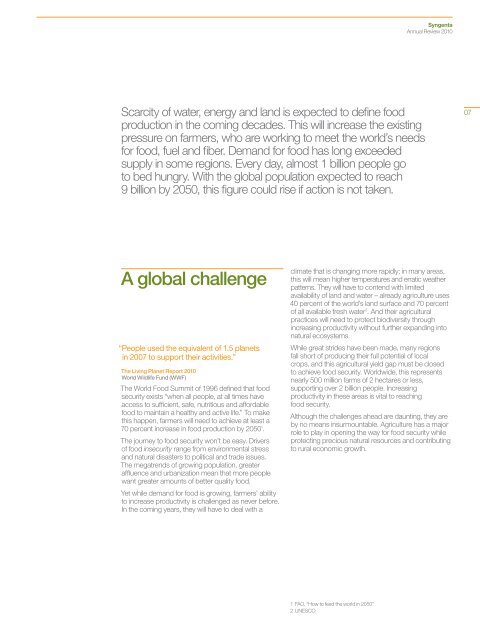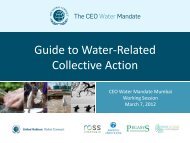Syngenta Annual Review 2010 - CEO Water Mandate
Syngenta Annual Review 2010 - CEO Water Mandate
Syngenta Annual Review 2010 - CEO Water Mandate
You also want an ePaper? Increase the reach of your titles
YUMPU automatically turns print PDFs into web optimized ePapers that Google loves.
<strong>Syngenta</strong><br />
<strong>Annual</strong> <strong>Review</strong> <strong>2010</strong><br />
Scarcity of water, energy and land is expected to define food<br />
production in the coming decades. This will increase the existing<br />
pressure on farmers, who are working to meet the world’s needs<br />
for food, fuel and fiber. Demand for food has long exceeded<br />
supply in some regions. Every day, almost 1 billion people go<br />
to bed hungry. With the global population expected to reach<br />
9 billion by 2050, this figure could rise if action is not taken.<br />
07<br />
A global challenge<br />
“People used the equivalent of 1.5 planets<br />
in 2007 to support their activities.”<br />
The Living Planet Report <strong>2010</strong><br />
World Wildlife Fund (WWF)<br />
The World Food Summit of 1996 defined that food<br />
security exists “when all people, at all times have<br />
access to sufficient, safe, nutritious and affordable<br />
food to maintain a healthy and active life.” To make<br />
this happen, farmers will need to achieve at least a<br />
70 percent increase in food production by 2050 1 .<br />
The journey to food security won’t be easy. Drivers<br />
of food insecurity range from environmental stress<br />
and natural disasters to political and trade issues.<br />
The megatrends of growing population, greater<br />
affluence and urbanization mean that more people<br />
want greater amounts of better quality food.<br />
Yet while demand for food is growing, farmers’ ability<br />
to increase productivity is challenged as never before.<br />
In the coming years, they will have to deal with a<br />
climate that is changing more rapidly; in many areas,<br />
this will mean higher temperatures and erratic weather<br />
patterns. They will have to contend with limited<br />
availability of land and water – already agriculture uses<br />
40 percent of the world’s land surface and 70 percent<br />
of all available fresh water 2 . And their agricultural<br />
practices will need to protect biodiversity through<br />
increasing productivity without further expanding into<br />
natural ecosystems.<br />
While great strides have been made, many regions<br />
fall short of producing their full potential of local<br />
crops, and this agricultural yield gap must be closed<br />
to achieve food security. Worldwide, this represents<br />
nearly 500 million farms of 2 hectares or less,<br />
supporting over 2 billion people. Increasing<br />
productivity in these areas is vital to reaching<br />
food security.<br />
Although the challenges ahead are daunting, they are<br />
by no means insurmountable. Agriculture has a major<br />
role to play in opening the way for food security while<br />
protecting precious natural resources and contributing<br />
to rural economic growth.<br />
1 FAO, “How to feed the world in 2050”<br />
2 UNESCO











